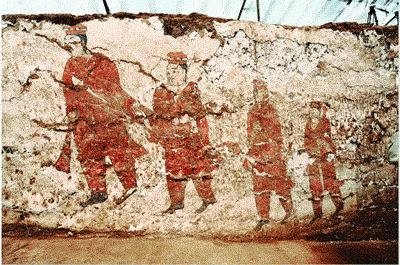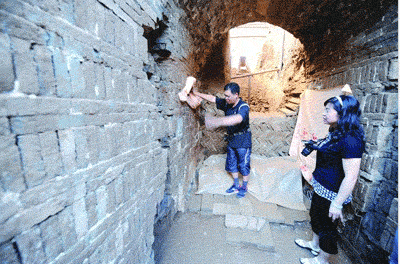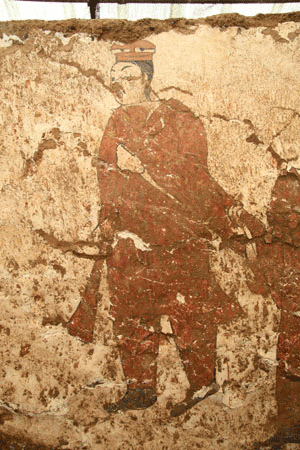A Royal Tomb of the Northern Qi Excavated in Cixian (Hebei)
An archaeological team from the Hebei Provincial Institute of Cultural Relics, in conjunction with Cixian County Preservation Office of Cultural Relics, conducted an archaeological excavation of a Northern Qi tomb (numbered M39) from February through August, 2009. The tomb is located along the main middle route of the South-to-North Water Diversion Project.
M39 is located in the middle west of a Northern Qi tomb cluster in Cixian County. The tomb is one of the numbered tombs in the site, which has been counted as a National Site of Cultural Relics Preservation. Specifically, M39 is 350 meters to Liuzhuang Village (Jiangwucheng Town, Cixian County). One point four kilometers to the east of the tomb is The Lanling King’s tomb. Two kilometers to its southwest is the “Mount of the Heavenly Son (tianzi zhong, numbered as M35 and said to be the mausoleum of the Xiaojing Emperor of the Eastern Wei). Three kilometers to its northeast is the “Great Tomb at Wanzhang” (Wanzhang damu, numbered as M106 and said to be the mausoleum of Gao Yang, the Wenxuan Emperor of the Northern Qi). The excavation has revealed that M39 is the tomb built for Gao Xiaoxu, the Xiucheng King of the Northern Qi.

A large tumulus of the tomb has survived. Due to the robbery, the tomb chamber had been severely damaged. Luckily, murals depicting the ceremonial army and painted on the two walls of the ramp have been preserved relatively well.
The configuration of the foundation of the tumulus is circular in shape, 41.5 meters from south to northern, 30 meters from east to west, and nearly 6 meters in height in its current state. The underground structure of the tomb consists of a ramp, a passageway, and a chamber. The tomb faces south and measures 25.7 meters in length. The ramp measures 15.8 meters and its orientation is 194°. The passageway measures 3.6 in length, 3.4 in height, and 2.8 meters in width. The brick-built passageway has straight walls and an arched ceiling. The plan of the tomb chamber is arced square in shape. The upper section of the pit is an arced rectangular and its lower section gradually shrinks to a rectangular. The pit is 7.6 meters from north to south and 7.5 meters from east to west, while the 30-square-metered chamber measures 5.2 meters from north to south and 5.6 meters from east to west. It has a hipped roof. Burial objects in the chamber, including the coffin bed and the pavement bricks, had long been robbed.
Surviving murals from the tomb measures 40 square meters. Originally, a plaster layer of 0.4 to 0.5 centimeter was first applied to the two walls of the ramp, the door of the passageway, and the brick walls of the chamber. On this plaster layer was painted with the murals. The ceremonial figures painted on the two walls of the ramp are symmetrical in composition, with 13 figures on each wall. The tallest figure is 1.4 meters in height and the shortest is 1.27 meters in height. Take the west wall as an example: forming the first unit of the composition, the four vanguard figures all wear a flat scarf, red Chinese style jacket, red pants, and black shoes, while carrying red wind and drum music instruments. The four figures following them constitute the second unit. They all wear a flat scarf, light blue Chinese style jacket, blue pants, and red shoes while carrying a club, the head of which is covered inside a sack and the tail of which bends slightly. The third unit consists of the following two figures. They all wear a soft hood, long fluttering scarf, and red, tight cuffed robe with buttons down the front. With belts decorated with pendants, they each wears black boots and carry a black mast with a three-tailed flag. The next three figures are partially damaged. Some traces of black boots, ceremonial flags, and ceremonial spears indicate that they are similar to those in the third unit.

The walls of the passageway as well as the door are painted with cloud patterns, lotuses, and scrolls. The outlines are done with ink, while the interior area is applied with orange red color. Some traces of lotus stems and bodyguards have survived on the west and east walls. Take the east wall for example: areas near the south end of the passageway are painted with a jeweled, grooved pillar that is decorated with flame pattern and stands on a girdled lotus seat. The pillar is 1.64 meters in height and supported by a pillar base in the shape of an inverted lotus. The three facets of the pillar are painted with red, black, and orange color. The middle section of the pillar is painted with girdled lotus peddles. The upper section is painted with lotus and inverted lotus peddles. On the top of the pillar is a jewel in flames. Behind the pillar are traces of a black-club-carrying figure with orange-colored cuffs and white flare pants.
Decoration on the four walls of the tomb chamber is by and large damaged with the exception of some traces of boots painted on the lower sections of these walls.

Two door leaves have been found inside the pit excavated by the robbers. Made of bluestone, they are 1.7 meters tall and 0.7 meter wide. A” Blue Dragon” and a “White Tiger” are engraved on the two door leaves. In the south of the tomb chamber has been found a stone lintel. It is half circular in shape, 1.3 meters long, and 0.7 meter tall. An animal mask is carved in its center, below which are the “Blue Dragon”, the “White Tiger”, and the “Dark Warrior.”
Because the tomb had been severely damaged, only a small portion of the original burial goods have survived, including 80 objects that can be reconstructed. These include pottery plates, pottery granaries, porcelain jars, painted pottery figurines, gild crown pendants, and Byzantine gold coins, among others. The types of the painted figurines include warriors with hands resting on the shields, figurines wearing armors, standing ceremonial figurines, and female figures. All these figurines are molded with further modification in details. After being heated, they are painted with different colors. The figurines are finely manufactured. Particularly, the fine depiction of the facial expression and clothe decoration bespeaks a realistic style.
A schist epitaph has been found at the southeast corner of the tomb chamber. Each side measures 0.8 meter long. The epitaph cover has a frustum-pyramid shape, with the following inscription carved on its face: “Daqi gu Xiuchengwang muzhiming (Epitaph of the Deceased Xiucheng King of the Great Qi).”At the four corners of the cover are traces of some iron hoops. At the four rims are patterns of animals, including the Blue Dragon, the White Tiger, the Dark Warrior, and a spirit animal.
The discovery of the tomb has some significant meanings for the field. First, the inscription on the epitaph provides some valuable evidence for analyzing the Northern Qi tombs in the vicinity of the tomb. This discovery not only helps us reconstruct the territory of the Northern Qi royal cemetery but also contributes greatly to our further discussion of the features of the royal cemeteries of the Eastern Wei and the Northern Qi in general. Second, the group of murals in the tomb, especially those ceremonial figures painted on the walls of the ramp, is the most significant discovery of this excavation. These figures are so depicted that they appear to be full-bodied. The floating and brief lines used are the concrete embodiment of the traditional “sparse painting” (shuti hua). These figures also constitute some evidence for studying the ceremonial system of the Northern Dynasties. The pillar with lotus patterns in the passageway is the first discovery of the same kind from Northern Dynasties tombs. Its form is similar to that of the pillars in the North and South Xiangtangshan Buddhist Caves in Fengfeng, Handan. This may indicate the Buddhist belief of the tomb occupant. Third, the tumulus of the tomb assumes a peculiar shape, which is rarely seen in Northern Qi tombs. It, thus, provides some intriguing raw materials for understanding the methods for constructing the tumulus during the Northern Qi. (Translated by Wang Yudong)

